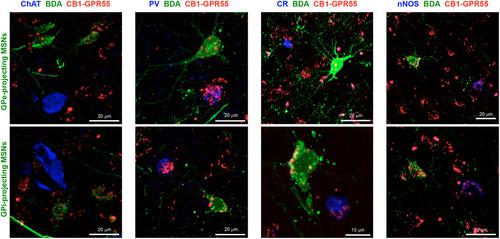当前位置:
X-MOL 学术
›
Ann. N. Y. Acad. Sci.
›
论文详情
Our official English website, www.x-mol.net, welcomes your
feedback! (Note: you will need to create a separate account there.)
Expression of cannabinoid CB 1 R–GPR55 heteromers in neuronal subtypes of the Macaca fascicularis striatum
Annals of the New York Academy of Sciences ( IF 4.1 ) Pub Date : 2020-06-27 , DOI: 10.1111/nyas.14413 Eva Martínez-Pinilla 1, 2, 3 , Alberto J Rico 4, 5, 6 , Rafael Rivas-Santisteban 6, 7, 8 , Jaume Lillo 6, 7, 8 , Elvira Roda 4, 5, 6 , Gemma Navarro 6, 8, 9 , Rafael Franco 6, 7, 8 , José Luis Lanciego 4, 5, 6
Annals of the New York Academy of Sciences ( IF 4.1 ) Pub Date : 2020-06-27 , DOI: 10.1111/nyas.14413 Eva Martínez-Pinilla 1, 2, 3 , Alberto J Rico 4, 5, 6 , Rafael Rivas-Santisteban 6, 7, 8 , Jaume Lillo 6, 7, 8 , Elvira Roda 4, 5, 6 , Gemma Navarro 6, 8, 9 , Rafael Franco 6, 7, 8 , José Luis Lanciego 4, 5, 6
Affiliation

|
The cannabinoid CB1 receptor (CB1R) is the most abundant G protein–coupled receptor in the central nervous system, consistent with the important role of endocannabinoids as neuromodulators. Cannabinoids also modulate the function of G protein–coupled receptor 55 (GPR55), which forms heteroreceptor complexes with the CB1R in the striatum. The aim was to characterize cannabinoid CB1R–GPR55 heteromers (CB1R/GPR55Hets) in the basal ganglia input nuclei of nonhuman primates, Macaca fascicularis, both in projection neurons and interneurons, by the in situ proximity ligation assay. Striatal projecting neurons were identified by the retrograde neuroanatomical tracer, biotinylated dextran amine (BDA), injected into external or internal subdivisions of the globus pallidus. Triple immunofluorescent stains were carried out to visualize (1) BDA‐labeled neurons, (2) CB1R/GPR55Hets, and (3) striatal interneurons positive for choline acetyltransferase, parvalbumin, calretinin, or nitric oxide synthase. CB1R/GPR55Hets were identified within both types of projection neurons as well as all interneurons except those that are cholinergic. Moreover, CB1R/GPR55Hets were found specifically in the neuronal cell surface, and also in intracellular membranes. Further research efforts will be needed to confirm the intracellular occurrence of heteromers and their potential as therapeutic targets in diseases related to motor control imbalances, particularly within a parkinsonian context (with or without levodopa‐induced dyskinesia).
中文翻译:

大麻素CB 1 R-GPR55异聚体在食蟹猴纹状体神经元亚型中的表达
大麻素 CB1 受体 (CB1R) 是中枢神经系统中最丰富的 G 蛋白偶联受体,这与内源性大麻素作为神经调节剂的重要作用一致。大麻素还调节 G 蛋白偶联受体 55 (GPR55) 的功能,GPR55 与纹状体中的 CB1R 形成异受体复合物。目的是通过原位邻近结扎试验在投射神经元和中间神经元的非人类灵长类动物的基底神经节输入核中表征大麻素 CB1R-GPR55 异聚体(CB1R/GPR55Hets)。纹状体投射神经元由逆行神经解剖示踪剂、生物素化葡聚糖胺 (BDA) 识别,注射到苍白球的外部或内部细分中。进行三重免疫荧光染色以观察 (1) BDA 标记的神经元,(2) CB1R/GPR55Hets,和 (3) 胆碱乙酰转移酶、小清蛋白、钙视网膜蛋白或一氧化氮合酶阳性的纹状体中间神经元。CB1R/GPR55Hets 在两种类型的投射神经元以及除胆碱能神经元之外的所有中间神经元中都被鉴定出来。此外,CB1R/GPR55Hets 特异地在神经元细胞表面和细胞内膜中发现。需要进一步的研究努力来确认异聚体的细胞内发生及其作为运动控制失衡相关疾病治疗靶点的潜力,特别是在帕金森病背景下(有或没有左旋多巴引起的运动障碍)。CB1R/GPR55Hets 在两种类型的投射神经元以及除胆碱能神经元之外的所有中间神经元中都被鉴定出来。此外,CB1R/GPR55Hets 特异地在神经元细胞表面和细胞内膜中发现。需要进一步的研究努力来确认异聚体的细胞内发生及其作为运动控制失衡相关疾病治疗靶点的潜力,特别是在帕金森病背景下(有或没有左旋多巴引起的运动障碍)。CB1R/GPR55Hets 在两种类型的投射神经元以及除胆碱能神经元之外的所有中间神经元中都被鉴定出来。此外,CB1R/GPR55Hets 特异地在神经元细胞表面和细胞内膜中发现。需要进一步的研究努力来确认异聚体的细胞内发生及其作为运动控制失衡相关疾病治疗靶点的潜力,特别是在帕金森病背景下(有或没有左旋多巴引起的运动障碍)。
更新日期:2020-06-27
中文翻译:

大麻素CB 1 R-GPR55异聚体在食蟹猴纹状体神经元亚型中的表达
大麻素 CB1 受体 (CB1R) 是中枢神经系统中最丰富的 G 蛋白偶联受体,这与内源性大麻素作为神经调节剂的重要作用一致。大麻素还调节 G 蛋白偶联受体 55 (GPR55) 的功能,GPR55 与纹状体中的 CB1R 形成异受体复合物。目的是通过原位邻近结扎试验在投射神经元和中间神经元的非人类灵长类动物的基底神经节输入核中表征大麻素 CB1R-GPR55 异聚体(CB1R/GPR55Hets)。纹状体投射神经元由逆行神经解剖示踪剂、生物素化葡聚糖胺 (BDA) 识别,注射到苍白球的外部或内部细分中。进行三重免疫荧光染色以观察 (1) BDA 标记的神经元,(2) CB1R/GPR55Hets,和 (3) 胆碱乙酰转移酶、小清蛋白、钙视网膜蛋白或一氧化氮合酶阳性的纹状体中间神经元。CB1R/GPR55Hets 在两种类型的投射神经元以及除胆碱能神经元之外的所有中间神经元中都被鉴定出来。此外,CB1R/GPR55Hets 特异地在神经元细胞表面和细胞内膜中发现。需要进一步的研究努力来确认异聚体的细胞内发生及其作为运动控制失衡相关疾病治疗靶点的潜力,特别是在帕金森病背景下(有或没有左旋多巴引起的运动障碍)。CB1R/GPR55Hets 在两种类型的投射神经元以及除胆碱能神经元之外的所有中间神经元中都被鉴定出来。此外,CB1R/GPR55Hets 特异地在神经元细胞表面和细胞内膜中发现。需要进一步的研究努力来确认异聚体的细胞内发生及其作为运动控制失衡相关疾病治疗靶点的潜力,特别是在帕金森病背景下(有或没有左旋多巴引起的运动障碍)。CB1R/GPR55Hets 在两种类型的投射神经元以及除胆碱能神经元之外的所有中间神经元中都被鉴定出来。此外,CB1R/GPR55Hets 特异地在神经元细胞表面和细胞内膜中发现。需要进一步的研究努力来确认异聚体的细胞内发生及其作为运动控制失衡相关疾病治疗靶点的潜力,特别是在帕金森病背景下(有或没有左旋多巴引起的运动障碍)。











































 京公网安备 11010802027423号
京公网安备 11010802027423号